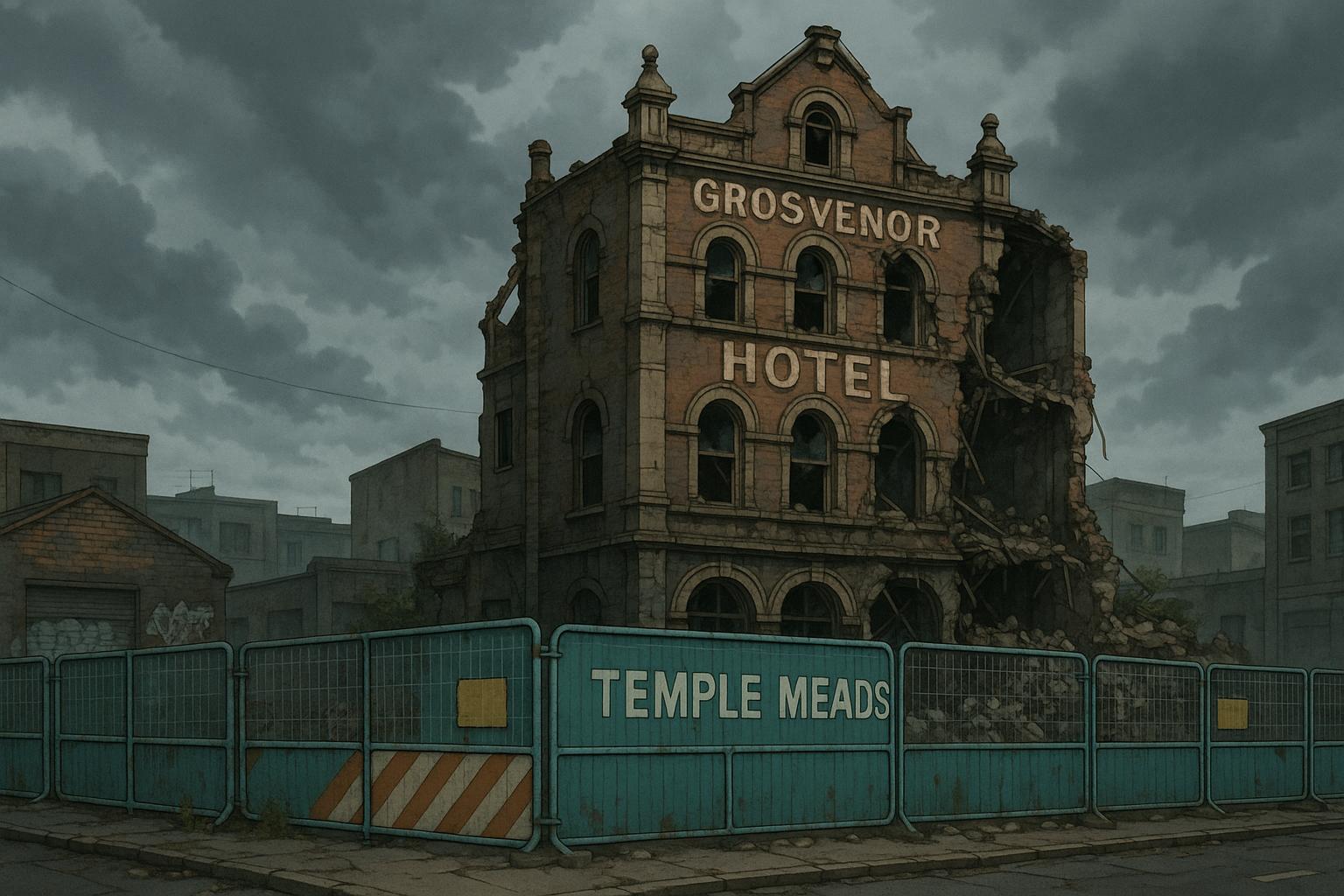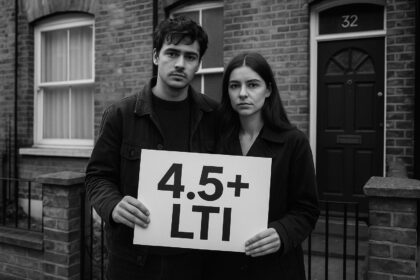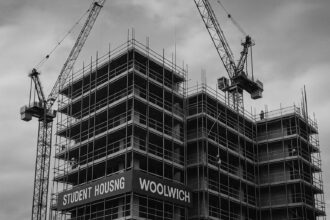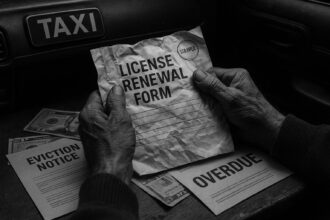The long-abandoned Grosvenor Hotel near Bristol Temple Meads has finally seen demolition work begin, yet plans to erect a large advertising billboard instead of new homes or offices have sparked fresh controversy, highlighting ongoing challenges in the city’s urban regeneration efforts.
The site of the Grosvenor Hotel has become synonymous with neglect and controversy in Bristol, exemplifying the complexities surrounding urban regeneration efforts. This half-demolished structure occupies a pivotal location near Bristol Temple Meads, presenting a grim first impression to visitors who arrive in the city by train or shuttle bus. Since February 2024, it has remained an eyesore, reflecting a protracted saga steeped in decay, unfulfilled promises, and community frustration.
Founded in 1875, the Grosvenor Hotel was once a prominent establishment designed by the esteemed architect S.C. Fripp, who was also known for his work on the Bristol Royal Infirmary. In its early years, the hotel catered to a stream of visitors—from business travellers to those heading to North America. Its grandeur faded over the decades, overshadowed by the rise of vehicular transport and subsequent urban development. The hotel closed its doors as a guest accommodation in 1993, transitioning first to a temporary homeless shelter before lying vacant for the last two decades.
The transition of the Grosvenor from a thriving hotel to a derelict site has been marred by a protracted struggle with authorities. Since the early 2000s, Bristol City Council has sought to exercise a Compulsory Purchase Order in an attempt to take control of the neglected property, an effort that has been met with resistance from its owner, Nimish Popat. The council’s frustrations reflect wider issues in urban management and the challenges of tethering private ownership to public responsibility.
Compounding this struggle was the disastrous incident in October 2022, when a fire broke out, believed to be deliberately set. This catastrophic event exacerbated the already dangerous aesthetic of the hotel, leading to serious structural concerns and the establishment of an exclusion zone that disrupted the surrounding area significantly. Local commuters faced multifaceted inconveniences, with pedestrian paths limited and public safety becoming a pressing concern.
As the years dragged on, various proposals aimed at revitalising the site circulated, but few bore fruit. A notorious scheme emerged in 2016 that promised to convert the hotel into 144 units of student accommodation, managed by the elusive businessman Sanjiv Varma. He claimed that potential investors could secure substantial returns on their ventures. Unfortunately, these promises turned out to be hollow; Varma was later exposed for selling units in a development that had neither ownership nor planning permission, ultimately resulting in his conviction for contempt of court.
In an unexpected turn, demolition work finally commenced in February 2024, a development hailed by local officials as a sign of progress. Yet, while the façade of the hotel was swiftly dismantled, the 1930s rear extension remained eerily intact, a surreal testament to a partially fulfilled court order. Meanwhile, during the completion of the demolition, it was revealed that the remnants would not be replaced by innovative residential units or office spaces; instead, plans to erect a large advertising billboard were submitted and approved by local planners.
This latest chapter in the Grosvenor saga raises broader questions about urban regeneration, the responsibilities of property owners, and the effectiveness of local councils in managing dilapidated properties. As Bristol continues its push toward a more vibrant cityscape, the fate of the Grosvenor Hotel stands as a stark reminder of the obstacles that can thwart the best-laid plans, leaving a trail of frustration among residents and authorities alike. The hope now lies in whether this prominent location can be transformed from a symbol of decay into a beacon of revitalisation, serving the community that has long endured its blighted presence.
Reference Map:
- Paragraph 1 – [1], [4]
- Paragraph 2 – [1], [2], [5]
- Paragraph 3 – [3], [6]
- Paragraph 4 – [1], [6], [7]
- Paragraph 5 – [1], [2], [5]
Source: Noah Wire Services
- https://www.bristolpost.co.uk/news/bristol-news/crazy-saga-bristols-worst-eyesore-10221142 – Please view link – unable to able to access data
- https://www.bbc.co.uk/news/uk-england-bristol-68191274 – In February 2024, demolition crews began dismantling the derelict Grosvenor Hotel in Bristol, a building that had been in a deteriorated state since a fire in October 2022. The fire had left the structure unsafe, leading to a court order for demolition. The hotel, once a luxurious establishment, had been vacant for over 20 years and was considered a significant eyesore in the city. The demolition was part of efforts to redevelop the area around Bristol Temple Meads station.
- https://www.bbc.co.uk/news/uk-england-bristol-63519941 – In October 2022, a large fire broke out at the derelict Grosvenor Hotel in Bristol, which was believed to have been started deliberately. The fire caused significant damage, rendering the building unsafe and leading to the evacuation of a neighbouring property. The incident highlighted the ongoing issues with the hotel’s condition and the challenges faced by authorities in addressing the site’s deterioration.
- https://www.bbc.co.uk/news/uk-england-bristol-68287662 – By February 2024, demolition work on the Grosvenor Hotel in Bristol had commenced but was halted shortly after starting. The building’s owner, Nimish Popat, faced multiple court actions from Bristol City Council, which demanded that he either make the building safe or demolish it. The council confirmed that contractors would complete the demolition by the end of March, aiming to address the building’s unsafe condition and the surrounding exclusion zone affecting public transport.
- https://www.itv.com/news/westcountry/2024-02-03/demolition-of-derelict-hotel-gets-underway – In early February 2024, demolition crews began dismantling the derelict Grosvenor Hotel in Bristol, a building that had been in a deteriorated state since a fire in October 2022. The fire had left the structure unsafe, leading to a court order for demolition. The hotel, once a luxurious establishment, had been vacant for over 20 years and was considered a significant eyesore in the city. The demolition was part of efforts to redevelop the area around Bristol Temple Meads station.
- https://www.bristolworld.com/news/grosvenor-hotel-update-on-bristol-eyesore-as-commuter-route-still-blocked-off-4389937 – As of October 2023, more than a year after the fire that severely damaged the Grosvenor Hotel in Bristol, commuter paths remained blocked. The building was in a dangerous condition, leading to the creation of an exclusion zone around it. This situation caused significant disruption to pedestrians and cyclists, who had to navigate a narrow temporary footpath. The council was in ongoing discussions with the building’s owner to address the safety concerns and the impact on the surrounding area.
- https://www.bristolworld.com/news/emails-between-council-and-owner-of-derelict-grosvenor-hotel-in-bristol-cannot-be-published-4424074 – In November 2023, it was reported that emails between Bristol City Council and the owner of the derelict Grosvenor Hotel could not be published due to potential distress. The council had previously refused a freedom of information request to release these communications, citing the risk of harassment through social media. The hotel had been empty for several years, and a fire in October 2022 had left it in a dangerous condition, leading to the establishment of an exclusion zone around the building.













